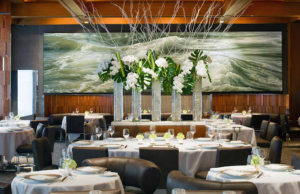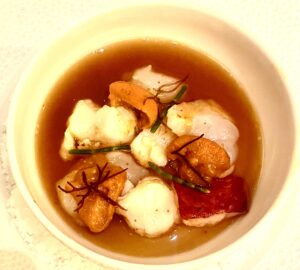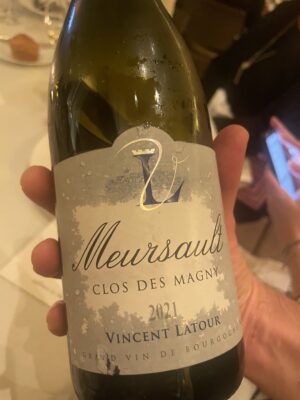Table Talk With Jeremy Wayne: Le Bernardin still dazzles

Let me take you on a journey – to Japan, via 51st Street in Manhattan. As regular readers of Table Talk know, when choosing restaurants to review, I usually stick to our plentiful backyard – Westchester and Fairfield counties, so rich these days in wonderful dining experiences. But just occasionally, I have a lunch or dinner so momentous that, even though outside our immediate area, I feel duty-bound to write about it.
That was the dinner I have just swooned over at the three-Michelin star Le Bernardin. Those three stars incidentally have been held for a record-18 years (since Michelin launched its guide in New York), with the restaurant also a consistent recipient of four-star reviews from The New York Times.
Full disclosure: I was a guest of JNTO, the Japan National Tourism Organization, and luxury travel and adventure company Abercrombie & Kent. And speaking of adventure, having not set foot inside Le Bernardin since just after its last glamorous facelift in 2012, I had forgotten just how much of a (culinary) adventure it was going to be.
The restaurant’s celebrated chef and co-owner Eric Ripert has a well-documented love of Japan. Japanese cuisine and culture have long informed the menu here, and this Japan-inspired dinner was no exception.
We began with tairagai, a highly-prized shellfish with a fan-like shell, somewhere between a mussel and an oyster in appearance, but with firmer flesh than either. Flown in daily from Japan, served with a saffron gelée and no more than a drop of extra virgin olive oil as a condiment, this starter was one of rare refinement. And the Alte Reben Brundimayer from Austria, an elegant expression of the luscious Grüner Veltliner grape varietal, made a superb accompaniment.

“Shellfish medley,” the unassuming name given to the second dish, gave barely a hint of how luxurious and exotic it was going to be. A kind of Japanese bouillabaisse of sea urchin, razor clam, langoustine, geoduck (giant clam) and shrimp custard in a smoked meat dashi broth, this stellar dish makes regular appearances on Le Bernardin’s menu. A rarefied piscatorial treat, it wove flavors and textures of the highest-grade shellfish together like shot silk. If you see it on the menu during your own visit to Le Bernardin, my advice is grab it. There weren’t enough superlatives in the book to convey what those deeply-layered, ocean-fresh tastes were like, especially when combined with the Meursault, Domaine Vincent Latour, Clos des Magny 2021 that we enjoyed with the “medley.” One of the finest Meursaults I have ever tried, it is currently available at Le Bernardin by the glass, like all the wines referred to in this piece.
All the dishes, or iterations of them, came from the main restaurant menu, although as that menu is subject to daily modification, no dish description can be written in stone. And here’s another thing: You won’t find words like “seasonal,” “chef-led,” or “farm-to-table” – platitudes that have become parodies of themselves through hollow overuse – at Le Bernardin. Chef Ripert, explaining his respect for the culinary arts in Japan before our meal commenced, had only one dry comment to make on that buzzword “seasonality,” by which we claim to hold such store. “In Japan,” he told us, “seasonality means following the seasons to the day.” Which really says it all, doesn’t it?
In a main course of hiramasa, or yellow amberjack, the delicate fish was sliced thin and pink as veal and served with meaty, roasted maitake mushrooms, which we know better as hen-of the-woods. Paired with a Brunello do Montalcino, Fattoria Colombini, Tuscany 2018, this was a superlative dish, although, almost impossibly, each dish seemed somehow to outdo the dish that had preceded it.

Other photographs by Jeremy Wayne.
Other refinements abounded. Like the sake, sipped from a beautiful, handmade glass bowl early on, with notes of honeysuckle on the tongue – the same sake, Ripert mentioned as an amusing aside, as served in first class on Japan Air Lines. Or the bread, an almost weightless brioche bun, at once dense and yet light as air, its appearance, texture, smell and taste each an individual sensation. (Cipriani is the only other restaurant in the city I know that can bake brioche with such flavor and finesse.)
In the dessert called “Baba” au Whisky, the menu put “baba” in quotation marks for a good reason. Sure, it tasted like soft, pillowy baba, classically made from flour, eggs and sugar. Of that there was no doubt. But there was somehow an extra dimension to the cake, although you’d have been hard pressed to know what it was. Enter purple sweet potato – and kindly stay there, because this “baba,” teased with whisky and given additional depth with caramelized pecans and smoked Okinawa sugar ice cream, was the perfect pudding.
(As I watched my fellow diners eating the same dessert at the same time, I swear I saw grown men and women with almost beatific expressions as they tasted that first transfixing bite.)
Although we ate in the recently inaugurated salon privé, I looked in at the main restaurant as well. Brimming over with old New York glamor but never for an instant stuffy, (think La Caravelle or Le Cirque meets Masa), the quietly elegant room is dominated by Ran Ortner’s 24-foot oil painting of the Pacific Ocean and simultaneously softened and made dramatic by great vases packed with exotic blooms. And let’s hear it for Le Bernardin’s front of house and wait-staff, too – battalions of waiters, moving silently, balletically, who always seem to know what you want before you yourself even know you want it.
For more, visit le-bernardin.com; japan.travel; and abercrombiekent.com.